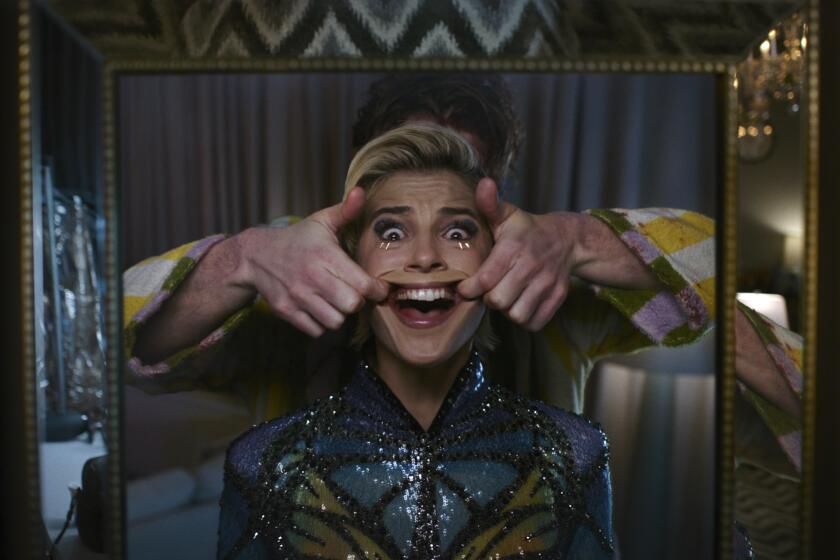Marcel Pagnol’s classic French films from the ‘30s get a long-overdue revival
Behold the multiple paradoxes of Marcel Pagnol.
Once upon a time he was France’s most celebrated filmmaker, the first of his craft to be selected to the lofty Academie Francaise. His best-known works from the 1930s, the warm and richly emotional trilogy of “Marius,” “Fanny” and “Cesar,” were once required viewing for cinephiles worldwide.
But not only has Pagnol’s once boldface name diminished in wattage, his work seems like an unlikely candidate for any kind of revival. For in many ways neither the filmmaker nor his contemporaries regarded what he did as cinema at all, and Pagnol, a famous playwright before he turned to movies, got into a celebrated feud with fellow director Rene Clair about just that.
“The talking picture is the art of recording, preserving and diffusing the theater,” Pagnol thundered. “A new field is open to the dramatist enabling him to produce works that neither Shakespeare, Racine nor Moliere had the means to attempt.”
Nothing daunted, Clair fired back, “the most striking thing about the writings of Pagnol and most of his colleagues is their cockiness and their astonishing ignorance of cinema.” No wonder, then, that American critic and French film specialist Richard Roud could write that Pagnol’s films “have been held in low esteem by the more serious critics.”
That, however, is changing in a big way. When the Pagnol trilogy (now spiffily rebranded as the Marseille trilogy) opened in New York’s prestigious Film Forum earlier this month, the city’s critics couldn’t contain their enthusiasm. With the same 4K restoration (worked on frame by frame for over 400 hours) set to open Jan. 27 at the Laemmle Royal, Los Angeles audiences will get to see what the fuss is about.
So how did this turnaround happen, how did these talky, admittedly theatrical films that date from the early days of the sound era end up the toast of a new century? The reasons are as fascinating and surprising as these deeply satisfying films and their humanistic concern with the demands and satisfactions of different kinds of love.
It’s simplest to start with Pagnol himself, a dramatist whose work centered on the Provence region of France and its key city of Marseille.
Pagnol’s plays were major Paris successes in the 1920s, and none more than “Marius,” the story of a young man, a waiter in a Marseille waterfront bar owned by his father Cesar. Marius is a romantic in love with Fanny, a young woman with a neighboring shellfish stall, but he’s also someone drawn with a powerful urgency to a life on the sea.
A writer with a gift for huge torrents of naturalistic dialogue, Pagnol had zero interest in silent cinema, but when he saw his first sound film (legend has it that was 1929’s “Broadway Melody”) he saw a way to bring his work to the entire world in one fell swoop.
When “Marius” was purchased by the French production arm of Paramount, Pagnol agreed to make the film in a way that sounds eccentric to the point of madness in today’s director-obsessed world.
Having selected the same actors he’d used for the play and having rehearsed them to his satisfaction, Pagnol was happy to turn the actual shooting of the 1931 film to a director for hire, who turned out to be, of all people, Alexander Korda, famous decades later as a British producer.
Pagnol hadn’t planned to write a theatrical sequel, but “Marius” was so open-ended and such a success as a play that he followed it up with “Fanny,” which was filmed in 1932 with the same cast and another director for hire, this time France’s Marc Allegret.
The great success on film of those two enabled Pagnol to form his own production company, build his own studio in Marseille and even acquire his own theaters. It also led him to write “Cesar,” the third part, directly for the screen and for the first time direct things himself.
In this final form, the Pagnol trilogy is in a sense an ancestor of television’s current rage for the limited series, a single literature-based tale told over more than six hours with the writer not the director as the key creative force.
As the relationships of Cesar, Marius, Fanny and her other suitor, the prosperous but considerably older merchant Panisse, grow in emotion and complexity over the course of these films, one of the core strengths of the enterprise, the power of the acting, comes into sharper and sharper focus.
Both Pierre Fresney (also known for a key role in Renoir’s “La Grand Illusion”) and Orane Demazis, who worked largely in theater, add new colors to their performances as lovers Marius and Fanny as time has its way with their situation, but Fernand Charpin as Panisse, as it turns out, changes even more.
Towering over all of them, however, is Raimu’s marvelous work as the crusty, blustering, heartsick father Cesar. Already a music hall comedy star when Pagnol first cast him on stage, Raimu’s work here, his ability to casually float from laughter to tragedy, is a key reason why colleagues from Marlene Dietrich to Zero Mostel considered him perhaps the best actor of his generation.
These characters all have marvelous speeches, a tribute to Pagnol’s gift for what he called “agile interchanges, linking and clashing in lively fashion, like two swords in trained hands.”
More than that, old as it is this trilogy will surprise you with its emotional and psychological complexities, a result of Pagnol’s ability to give a full and convincing hearing to each of his protagonists’ often competing truths.
It was Pagnol’s passion for performance and language that began to change minds about him, starting with key French critic Andre Bazin and extending to Richard Roud, who wrote that Pagnol intuitively understood that “what happened during a shot was just as important as the relationship between the shots. That mise-en-scène was first and foremost the choice and direction of actors — they were the true raw material of cinema.”
But at its core the resurgence of Pagnol’s fortunes had less to do with cinematic reasons than emotional ones, the same reasons that led chef Alice Waters, a huge fan of the trilogy, to name her celebrated Berkeley restaurant Chez Panisse and her daughter Fanny.
The Chez Panisse website opens with a clip of actress Demazis as Fanny and Waters is quoted as saying she chose the name as “an homage to the sentiment, comedy and informality of these classic films.” Pagnol himself couldn’t have put it any better.
Three films of Marcel Pagnol
Where: Laemmle Royal Theater, West Los Angeles
When: Friday Jan. 27-Thurs Feb. 2. Each film will play at least once on each day, contact theater for specific schedule. The films should be seen in order.
More to Read
Only good movies
Get the Indie Focus newsletter, Mark Olsen's weekly guide to the world of cinema.
You may occasionally receive promotional content from the Los Angeles Times.











